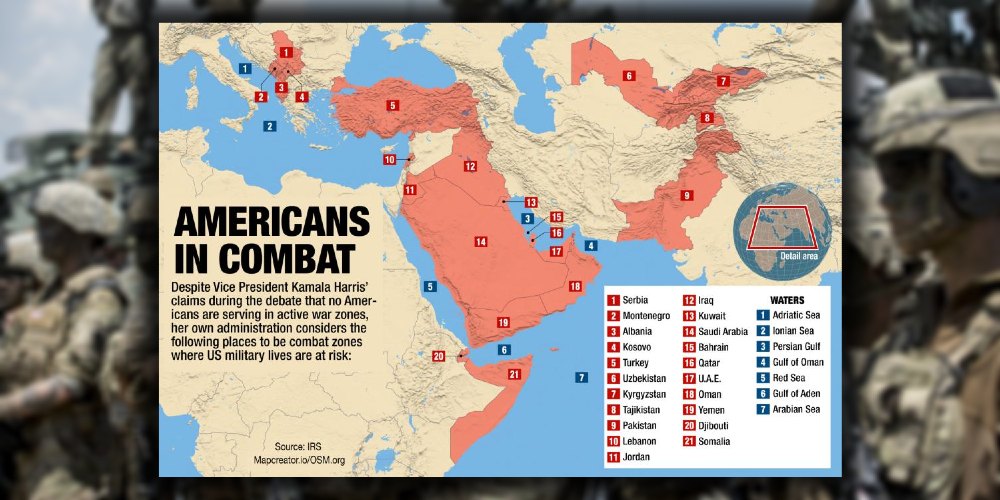In what can only be described as a politically motivated façade, Vice President Kamala Harris boldly declared during the ABC debate that no American troops are actively engaged in combat zones. This claim starkly contradicts the realities faced by thousands of U.S. service members stationed across the Middle East and Africa, who are currently receiving “hostile fire” or “imminent danger pay.”
As NY Post noted:
Outraged family members of US troops hurt in the line of duty slammed Kamala Harris’ brazen claim that no Americans are serving in war zones — a statement which flies in the face of her own administration’s official list of active combat zones.
As many as 50,000 US service members currently patrolling countries and oceans across the Middle East and Africa are receiving either “hostile fire” or “imminent danger pay,” monthly payments of up to $225 for troops deployed in areas where they could easily be subjected to — or do come under — enemy attack, retired Army Col. and military analyst Jonathan Sweet told The Post.
Yet during Tuesday’s ABC debate with Republican presidential nominee Donald Trump, the vice president to make it seem as if the Harris-Biden administration has heralded in a period of peace not seen in decades — and that all American military members are safe.
This was an attempt by the Harris campaign to paint a rosy picture of global affairs under their governance, conveniently overlooking the harsh truths.
“As of today there is not one member of the United States military who is in active duty in a combat zone, in any war zone around the world, for the first time this century.” – Kamala Harris
Now, let’s dissect the implications of such a statement. Firstly, it’s essential to recognize the gravity of the situation where service members like Chief Warrant Officer Garrett Illerbrunner are critically injured in active duty. His father, Brad Illerbrunner, expressed profound disappointment and anger towards Harris’s misleading assertions.
“really [hit] below the belt… She doesn’t even recognize that our own troops are getting hurt.” – Brad Illerbrunner
“We’re still in war zones.” – Brad Illerbrunner
“trying to snow the public.” – Brad Illerbrunner
These poignant words from a distressed father highlight the disconnect between the administration’s narrative and the ground realities. How can such blatant disregard for the truth be justified? Is it merely a ploy to divert the public’s attention from the ongoing dangers faced by our troops?
Michael DiMino, a fellow at the think tank Defense Priorities, also criticized the vice president’s claims for failing to reflect the true conditions experienced by U.S. forces deployed overseas.
Important: Our sponsors at Jase are now offering emergency preparedness subscription medications on top of the long-term storage antibiotics they offer. Use promo code “Rucker10” at checkout!
“fail a basic kind of smell test” – Michael DiMino
“If you’re in Jordan in the middle of nowhere to fight ISIS, and you’re getting attacked by Iranian drones and rockets on a daily basis, you’re in a war zone.” – Michael DiMino
“to finagle a wording… to make a point we’re not engaged in all these conflicts — which we are” – Michael DiMino
“Those quibbling qualifiers ignore the fact American men and women in uniform are getting shot at on daily basis, and many just in the last eight months have died or been injured.” – Michael DiMino
Despite these glaring facts, a Harris campaign spokeswoman and a Defense Department official reiterated the administration’s stance, further fueling the narrative disconnect.
“taking risks for our country that should be honored no matter where they serve.” – Harris campaign spokeswoman
“An aspect of military service includes serving in locations where hostile actions may occur… Those locations are designated by executive order and/or the Secretary of Defense. However, it’s important to note that just because a service member is in one of these locations does not mean they are engaged in war.” – Defense Department official
The emotional toll on families is palpable. Holly Davis, whose husband is currently deployed in Syria, shared her distress over the vice president’s claims, which starkly contrast with her daily reality.
“It’s very hurtful that someone who is currently our vice president is making these claims when my husband is literally sacrificing his life every day over in the Middle East.” – Holly Davis
“I had to sit in those literal two minutes of hearing that, wondering if he was going to come back on the phone… It’s very real. Very war zone.” – Holly Davis
The Harris-Biden administration’s portrayal of a peaceful, conflict-free global stage under their leadership does not hold up against the testimonies of those directly impacted by the realities of war. This discrepancy begs the question: What is the true cost of these politically motivated assertions, and who really pays the price? Moreover, can anyone believe anything that Kamala Harris says?

It’s becoming increasingly clear that fiat currencies across the globe, including the U.S. Dollar, are under attack. Paper money is losing its value, translating into insane inflation and less value in our life’s savings.
Genesis Gold Group believes physical precious metals are an amazing option for those seeking to move their wealth or retirement to higher ground. Whether Central Bank Digital Currencies replace current fiat currencies or not, precious metals are poised to retain or even increase in value. This is why central banks and mega-asset managers like BlackRock are moving much of their holdings to precious metals.
As a Christian company, Genesis Gold Group has maintained a perfect 5 out of 5 rating with the Better Business Bureau. Their faith-driven values allow them to help Americans protect their life’s savings without the gimmicks used by most precious metals companies. Reach out to them today to see how they can streamline the rollover or transfer of your current and previous retirement accounts.


